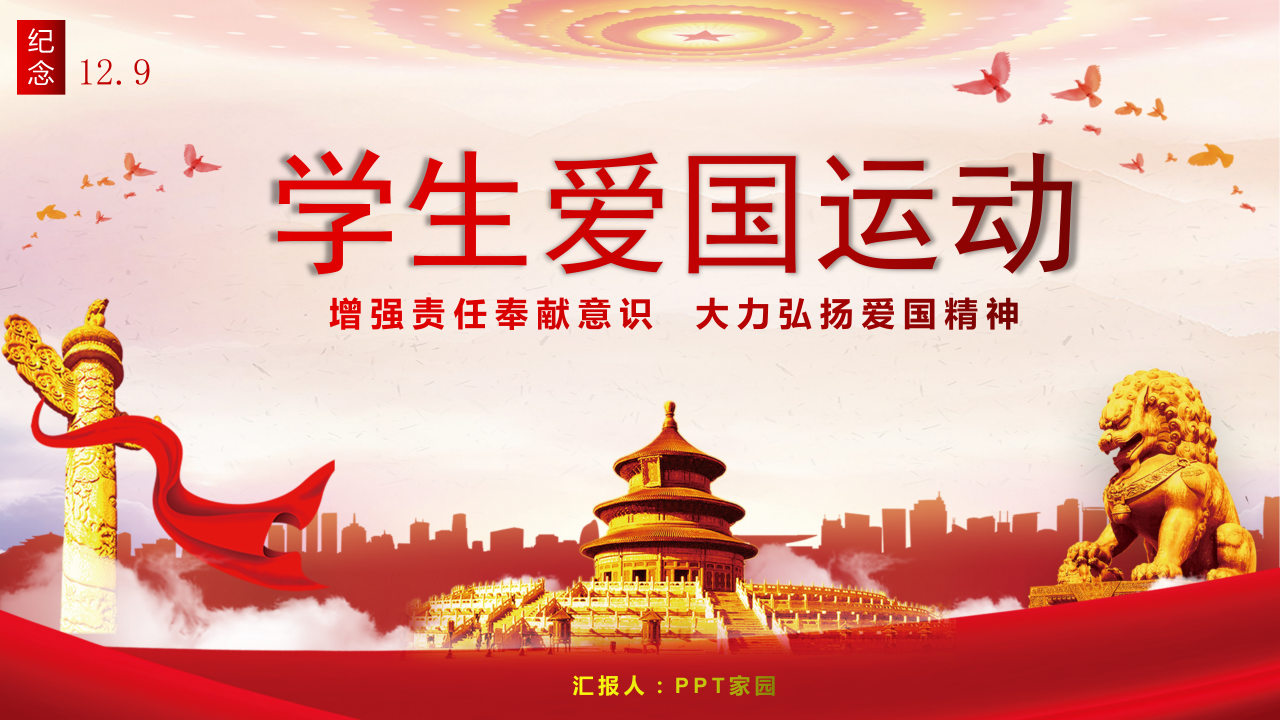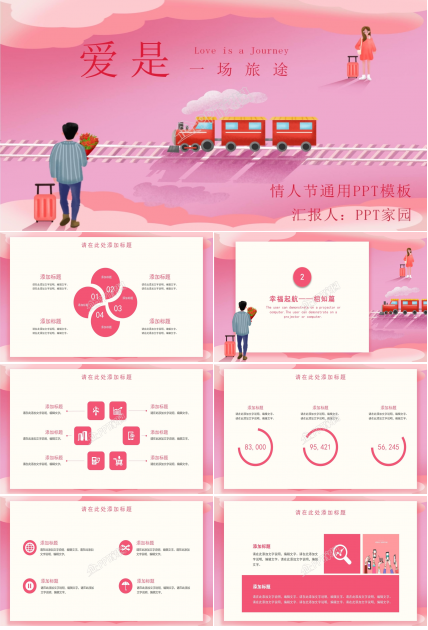故宫ppt模板怎么做?故宫博物院导游PPT怎么做?
2023-03-28 22:07 责任编辑:pptjia
关于故宫介绍的ppt 故宫始建于公元1406,1420年基本竣工,是明朝皇帝朱棣始建。故宫南北长961米,东西宽753米,面积约为725,000平方米。建筑面积15.5万平方米。相传故宫一共有999
关于故宫介绍的ppt
故宫始建于公元1406,1420年基本竣工,是明朝皇帝朱棣始建。故宫南北长961米,东西宽753米,面积约为725,000平方米。建筑面积15.5万平方米。相传故宫一共有9999.5间,实际据1973年专家现场测量故宫有大小院落90多座,房屋有980座,共计8704间(而此“间”并非现今房间之概念,此处“间”指四根房柱所形成的空间)。宫城周围环绕着高12米,长3400米的宫墙,形式为一长方形城池,墙外有52米宽的护城河环绕,形成一个森严壁垒的城堡。故宫宫殿建筑均是木结构、黄琉璃瓦顶、青白石底座,饰以金碧辉煌的彩画。故宫有4个门,正门名午门,东门名东华门,西门名西华门,北门名神武门。面对北门神武门,有用土、石筑成的景山,满山松柏成林。在整体布局上,景山可说是故宫建筑群的屏障。
故宫的建筑依据其布局与功用分为“外朝”与“内廷”两大部分。“外朝”与“内廷”以乾清门为界,乾清门以南为外朝,以北为内廷。故宫外朝、内廷的建筑气氛迥然不同。
外朝以太和、中和、保和三大殿为中心,是皇帝举行朝会的地方,也称为“前朝”。是封建皇帝行使权力、举行盛典的地方。此外两翼东有文华殿、文渊阁、上驷院、南三所;西有武英殿、内务府等建筑。
内廷以乾清宫、交泰殿、坤宁宫后三宫为中心,两翼为养心殿、东、西六宫、斋宫、毓庆宫,后有御花园。是封建帝王与后妃居住之所。内廷东部的宁寿宫是当年乾隆皇帝退位后养老而修建。内廷西部有慈宁宫、寿安宫等。此外还有重华宫,北五所等建筑。
建筑特色
故宫严格地按《周礼・考工记》中“前朝后市,左祖右社”的帝都营建原则建造。整个故宫,在建筑布置上,用形体变化、高低起伏的手法,组合成一个整体。在功能上符合封建社会的等级制度。同时达到左右均衡和形体变化的艺术效果。中国建筑的屋顶形式是丰富多彩的,在故宫建筑中,不同形式的屋顶就有10种以上。以3大殿为例,屋顶各不相同。故宫建筑屋顶满铺各色琉璃瓦件。主要殿座以黄色为主。绿色用于皇子居住区的建筑。其它蓝、紫、黑、翠以及孔雀绿、宝石蓝等五色缤纷的琉璃,多用在花园或琉璃壁上。太和殿屋顶当中正脊的两端各有琉璃吻兽,稳重有力地吞住大脊。吻兽造型优美,是构件又是装饰物。一部分瓦件塑造出龙凤、狮子、海马等立体动物形象,象征吉祥和威严,这些构件在建筑上起了装饰作用。
故宫前部宫殿,当时建筑造型要求宏伟壮丽,庭院明朗开阔,象征封建政权至高无上,太和殿坐落在紫禁城对角线的中心,故宫的设计者认为这样以显示皇帝的威严,震慑天下。后部内廷却要求庭院深邃,建筑紧凑,因此东西六宫都自成一体,各有宫门宫墙,相对排列,秩序井然,再配以宫灯联对,绣榻几床,都是体现适应豪华生活需要的布置。内廷之后是宫后苑。后苑里有岁寒不雕的苍松翠柏,有秀石迭砌的玲珑假山,楼、阁、亭、榭掩映其间,幽美而恬静。
故宫宫殿是沿着一条南北向中轴线排列,三大殿、后三宫、御花园都位于这条中轴线上。并向两旁展开,南北取直,左右对称。这条中轴线不仅贯穿在紫禁城内,而且南达永定门,北到鼓楼、钟楼,贯穿了整个城市,气魄宏伟,规划严整,极为壮观。
故宫是几百年前劳动人民智能和血汗的结晶。初建时被奴役的劳动者有工匠十万,夫役百万。在当时社会生产条件下,能建造这样宏伟高大的建筑群,充分反映了中国古代劳动人民的高度智能和创造才能。同时,为了修建故宫,如所需的木材,在明代时,大多采自四川、广西、广东、云南、贵州等地,无数劳动人民被迫在崇山峻岭中的原始森林里,伐运木材。所用石料多采自北京远郊和距京郊二三百里的山区。每块石料往往重达几吨甚至几十、几百吨,如现在保和殿后檐的台阶,有一块云龙雕石重约250吨。
建筑学家们认为故宫的设计与建筑,实在是一个无与伦比的杰作,它的平面布局,立体效果,以及形式上的雄伟、堂皇、庄严、和谐,建筑气势雄伟、豪华壮丽,是中国古代建筑艺术的精华。它标志着中国悠久的文化传统,显示着五百多年前匠师们在建筑上的卓越成就。
故宫英文介绍ppt
故宫. ※
What strikes one first in a bird's -eye view of Beijing proper is a vast tract of golden roofs flashing brilliantly in the sun with purple walls occasionally emerging amid them and a stretch of luxuriant tree leaves flanking on each side. That is the former Imperial Palace, popularly known as the Forbidden City, from which twenty-four emperors of the Ming and Qing Dynasties ruled China for some 500 years--from1420 to 1911. The Ming Emperor Yong Le, who usurped the throne from his nephew and made Beijing the capital, ordered its construction, on which approximately 10,000 artists and a million workmen toiled for 14 years from 1406 to 1420. At present, the Palace is an elaborate museum that presents the largest and most complete ensemble of traditional architecture complex and more than 900,000 pieces of court treasures in all dynasties in China.
Located in the center of Beijing, the entire palace area, rectangular in shape and 72 hectares in size, is surrounded by walls ten meters high and a moat 52 meters wide. At each corner of the wall stands a watchtower with a double-eave roof covered with yellow glazed tiles.
The main buildings, the six great halls, one following the other, are set facing south along the central north-south axis from the Meridian Gate, the south entrance, to Shenwumen, the great gate piercing in the north wall. On either side of the palace are many comparatively small buildings. Symmetrically in the northeastern section lie the six Eastern Palaces and in the northwestern section the six Western Palaces. The Palace area is divided into two parts: the Outer Court and the Inner Palace. The former consists of the first three main halls, where the emperor received his courtiers and conducted grand ceremonies, while the latter was the living quarters for the imperial residence. At the rear of the Inner Palace is the Imperial Garden where the emperor and his family sought recreation.
The main entrance to the Palace is the Meridian Gate(1), which was so named because the emperor considered himself the "Son of the Heaven" and the Palace the center of the universe, hence the north-south axis as the Meridian line going right through the Palace. The gate is crowned with five towers, commonly known as the Five-Phoenix Towers(2), which were installed with drums and bells. When the emperor went to the Temple of Heaven, bells were struck to mark this important occasion. When he went to the Ancestral Temple, it was the drums that were beaten to publicize the event.
Beyond the Meridian Gate unfolds a vast courtyard across which the Inner Golden Water River runs from east to west. The river is spanned by five bridges, which were supposed to be symbols of the five virtues preached by Confucius--benevolence, righteousness, rites, intelligence, and fidelity(3).
At the north end of the courtyard is a three-tiered white marble terrace, seven meters above the ground, on which, one after another, stand three majestic halls; the Hall of Supreme Harmony(4), the Hall of Complete Harmony(5), and the Hall of Preserving Harmony(6).
The Hall of Supreme Harmony, rectangular in shape, 27 meters in height, 2,300 square meters in area, is the grandest and most important hall in the Palace complex. It is also China's largest existing palace of wood structure and an outstanding example of brilliant color combinations. This hall used to be the throne hall for ceremonies which marked great occasions: the Winter Solstice, the Spring Festival, the emperor's birthday and enthronement, and the dispatch of generals to battles, etc. On such occasions there would be an imperial guard of honor standing in front of the Hall that extended all the way to the Meridian gate.
On the north face of the hall in the center of four coiled-golden dragon columns is the "Golden Throne", which was carved out of sandalwood. The throne rests on a two-meter-high platform with a screen behind it. In front of it, to the left and right, stand ornamental cranes, incense burners and other ornaments. The dragon columns entwined with golden dragons measure one meter in diameter. The throne itself, the platform and the screen are all carved with dragon designs. High above the throne is a color-painted coffered ceiling which changes in shape from square to octagonal to circular as it ascends layer upon layer. The utmost central vault is carved with the gilded design of a dragon toying with pearls. when the Emperor mounted the throne, gold bells and jade chimes sounded from the gallery, and clouds of incense rose from the bronze cranes and tortoises and tripods outside the hall on the terrace. The aura of majesty created by the imposing architecture and solemn ritual were designed to keep the subjects of the "Son of the Heaven" in awe and reverence.
The Hall of Complete Harmony is smaller and square with windows on all sides. Here the emperor rehearsed for ceremonies. It is followed by the Hall of Preserving Harmony in which banquets and imperial examinations were held.
Behind the Hall of Preserving Harmony lies a huge marble ramp with intertwining clouds and dragons carved in relief. The slab, about 6.5 meters long, 3 meters wide and 250 tons in weight, is placed between two flights of marble steps along which the emperor's sedan was carried up or down the terrace. It is the largest piece of stone carving in the Imperial Palace. Quarried in the mountains scores of kilometers southwest of Beijing, this gigantic stone was moved to the city by sliding it over a specially paved ice road in winter. To provide enough water to build the ice road, wells were sunk at very 500 meters along the way.
The three halls of the Inner Palace are replicas of the three halls in the front, but smaller in size. They are the Palace of Heavenly Purity(7), the Hall of Union(8), and the Palace of Earthly Tranquility(9).
The Palace of Heavenly Purity was once the residence of the Ming emperors and the first two of the Qing emperors. Then the Qing Emperor Yong Zheng moved his residence to the Palace of Mental Cultivation and turned it into an audience hall to receive foreign envoys and handled the state affairs. The promotion and demotion of officials were also decided in this hall. After the emperor's death his coffin was placed here for a 49-day period of mourning.
The Palace of Union was the empress's throne room and the Hall of Earthly Tranquility, once a private living room for the empress, was partitioned. The west chamber served religious purposes and the east one was the bridal chamber where the newly married emperor and empress spent their first two nights after their wedding.
The Imperial Garden was laid out during the early Ming dynasty. Hundreds of pines and cypresses offer shade while various flowers give colors to the garden all year round and fill the air with their fragrance. In he center of the garden is the Hall of Imperial Peace, a Daoist temple, with a flat roof slightly sloping down to the four eaves. This type of roof was rare in ancient Chinese architecture. In he northeastern corner of the garden is a rock hill, known as the Hill of the Piled-up Wonders, which is topped with a pavilion. At the foot of the hill are two fountains which jet two columns of water high into the air. It is said that on the ninth night of the ninth month of the lunar calendar, the empress would mound the hill to enjoy the autumn scene. It is also believed that climbing to a high place on that day would keep people safe from contagious diseases.
The six Western Palaces were residences for empresses and concubines. They are kept in their original way for show. The six Eastern Palaces were the residences for them too. But now they serve as special museums: the Museum of Bronze, the Museum of Porcelain and the Museum of Arts and Crafts of the Ming and Qing dynasties. In the northeastern-most section of the Inner Palace are the Museum of Traditional Chinese Paintings and the Museum of Jewelry and Treasures where rare pieces of imperial collections are on display.
Now the Forbidden City is no longer forbidding, but inviting. A visit to the Palace Museum will enrich the visitors' knowledge of history, economy, politics, arts as well as architecture in ancient China.
Notes:
1. the Meridian Gate 午门
2. the Five-Phoenix Towers 五凤楼
3. benevolence, righteousness, rites, intelligence, and fidelity 仁、义、礼、智、信
4. the Hall of Supreme Harmony 太和殿
5. the Hall of Complete Harmony 中和殿
6. the Hall of Preserving Harmony 保和殿
7. the Palace of Heavenly Purity 乾清宫
8. the Hall of Union 交泰殿
9. the Palace of Earthly Tranquility 坤宁宫
故宫博物院导游PPT
要根据客人的学历、客源地、爱好的不同设计不同的导游词 宫午门前) 各位朋友,过一会儿我们将参观故宫博物院,现在我先为大家作个简单介绍。故宫
热门标签更多
相关推荐
-

怎么做免费分享快闪自我介绍ppt模板?怎么做免费分享快闪自我介绍ppt模板详细步骤?
本文详细介绍了制作快闪自我介绍ppt模板的步骤,包括确定主题和目标受众、设计ppt布局、选用合适的图片和字体、加入动画和音效以及测试等方面。欢迎关注PPT家园了解更多ppt制作技巧。.........
2023-06-14
-

怎么做逃避英文自我介绍模板ppt?怎么做逃避英文自我介绍模板ppt详细步骤?
本文介绍了制作英文自我介绍模板PPT的方法,包括设计主题、编写内容、选择模板、添加图片和练习演讲等步骤。同时还推荐了一个PPT资源网站PPT家园,可以帮助PPT爱好者提升技巧和获取资源。.........
2023-06-12
-

怎么做培训时自我介绍ppt模板?怎么做培训时自我介绍ppt模板详细步骤?
本文详细介绍制作自我介绍ppt模板的方法,包括确定主题、选择模板、设计布局、选择字体和颜色、正确使用图像、添加动画效果、编辑等方面。同时推介PPT家园,提供最新的PPT技巧和素材,帮助学生、教师、企业家提高展示和推销技巧。.........
2023-06-12
-

2023学生汇报ppt模板怎么做?
这篇文章详细介绍了2023学生汇报ppt模板的大纲内容,包括简介、模板使用说明、结构与设计风格、功能与特性以及使用案例展示等部分。.........
2023-04-13
-

ppt素材服务器设计怎么做?ppt素材服务器的制作方法
本文从设计者的角度出发,详细介绍了PPT素材服务器的作用和制作方法,帮助企业快速管理PPT素材,提高效率。.........
2023-06-12
-

怎么做职业生涯规划人物访谈答辩ppt?怎么做职业生涯规划人物访谈答辩ppt详细步骤?
本文介绍了制作职业生涯规划人物访谈答辩ppt的方法,包括确定主题和目的、整理资料和素材、选择合适的模板、编写幻灯片内容、增强互动性和总结回顾等方面。同时,还提供了相关的关键词和标签,方便读者查找相关信息。.........
2023-06-19
-

怎么做助产学职业生涯规划ppt?怎么做助产学职业生涯规划ppt详细步骤?
制作助产学职业生涯规划ppt需要注意主题和目的、采集和整理信息、制定ppt结构和样式、注意文字和图片搭配、注意动画和音效的运用、以及注意版式和排版,详情见PPT家园。.........
2023-06-15
-

小学生常用ppt模板怎么做?小学生常用ppt模板制作技巧
制作PPT可以帮助小学生更好地表达自己的想法和知识,以下是一些小学生常用PPT模板制作技巧和大纲介绍。.........
2023-05-10
-

怎么做护理自我介绍ppt模板免费下载?怎么做护理自我介绍ppt模板免费下载详细步骤?
本文介绍了制作护理自我介绍ppt模板的步骤和方法,包括确定主题、规划内容、选取模板、编辑及优化等方面。希望对需要制作护理自我介绍ppt模板的同学有所帮助。.........
2023-06-13
-









 扫码加微信客服有好礼
扫码加微信客服有好礼